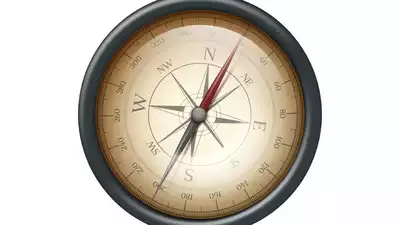- News
- Education News
- Learning with TOI News
- Explained: The science behind how compasses work
Trending
This story is from April 27, 2023
Explained: The science behind how compasses work
A compass is a navigational tool that helps people find their direction using the earth's magnetic field. It contains a magnet that aligns itself with the earth's north pole to indicate the direction. Its relevance persists today, aiding aviation, shipping, outdoor recreation, and technology.

Representative image via Freepik
A compass is a tool that helps you find your way in the right direction, just like a map. The science behind how a compass works is based on a special kind of rock called magnetite. This rock has a property that makes it attract metal objects like iron, and it always points in the same direction.
Inside a compass, there is a tiny magnet that is free to move.When you hold the compass flat, the magnet inside it will turn until it is pointing towards the north pole. This is because the earth itself is like a giant magnet, with its own north and south poles. The magnet in the compass aligns with the earth's magnetic field, pointing towards the north.
By using a compass, you can tell which direction you are facing, and which way to go to get where you want to go. It's a very useful tool for hikers, campers, and anyone who wants to explore the great outdoors!
History of compass
The ancient Chinese discovered the properties of lodestone, a naturally occurring magnetized mineral, and began using it to make navigational tools. They would float a lodestone on a piece of cork in a bowl of water, allowing it to rotate freely until the lodestone pointed towards the south, which they called the "red needle."
By the 11th century, the Chinese had developed the "south-pointing needle," which had a magnetized needle that always pointed south, making it a more accurate navigational tool. They used this new design for land and sea navigation and developed sophisticated maps and compasses for accurate navigation.
The compass then spread to other parts of the world, including the Arab world and Europe. Arab sailors played a critical role in spreading the use of the compass to Europe during the Middle Ages, and by the 13th century, the compass was a standard tool for European sailors and navigators.
With the development of the magnetic compass, the world became a more connected place. The compass allowed for more accurate navigation, leading to improved trade, exploration, and the spread of ideas across different cultures.
Today, the compass continues to be an essential tool for navigation, used in a wide range of applications, including aviation, shipping, and outdoor recreation. It has become an integral part of our modern world and an essential component of modern technology.
How to use
Using a compass is a simple and fun way to find your way in the great outdoors. Here's how to use a compass:
For example, let's say you're hiking in the woods and want to find your way back to your campsite. You can use a compass to help you find the right direction to go. First, you would hold the compass flat in your hand, making sure it's level and facing away from your body. Then, you would turn your body until the north end of the needle on the compass is aligned with the north end of the compass housing. Next, you would look for a landmark, like a distinctive tree or rock, that is in the direction of your campsite. You would then use the compass to keep yourself on track as you walk towards the landmark and eventually back to your campsite.
The Earth has a big invisible force field around it called the magnetic field, which is created by the movement of molten iron in the Earth's core. This magnetic field is like a giant bar magnet, with a north pole and a south pole.
Just like a regular magnet, the Earth's magnetic field attracts certain types of metals, like iron, towards its north and south poles. This is why a compass needle always points toward the north pole, because the needle is attracted to the north pole of the Earth's magnetic field.
The Earth's magnetic field is important for many reasons. It protects us from harmful radiation and particles from the sun and other space objects, which would otherwise be dangerous for us and other living things on Earth. It also helps animals like birds and fish to navigate and find their way during migration.
The Earth's magnetic field is constantly changing and can vary in strength and direction. Scientists study these changes to better understand our planet and how it works.
(The content is generated with the assistance of Artificial Intelligence)
Inside a compass, there is a tiny magnet that is free to move.When you hold the compass flat, the magnet inside it will turn until it is pointing towards the north pole. This is because the earth itself is like a giant magnet, with its own north and south poles. The magnet in the compass aligns with the earth's magnetic field, pointing towards the north.
By using a compass, you can tell which direction you are facing, and which way to go to get where you want to go. It's a very useful tool for hikers, campers, and anyone who wants to explore the great outdoors!
History of compass
The history of the compass goes back thousands of years, and its invention is a result of a long process of discovery and experimentation.
The ancient Chinese discovered the properties of lodestone, a naturally occurring magnetized mineral, and began using it to make navigational tools. They would float a lodestone on a piece of cork in a bowl of water, allowing it to rotate freely until the lodestone pointed towards the south, which they called the "red needle."
By the 11th century, the Chinese had developed the "south-pointing needle," which had a magnetized needle that always pointed south, making it a more accurate navigational tool. They used this new design for land and sea navigation and developed sophisticated maps and compasses for accurate navigation.
The compass then spread to other parts of the world, including the Arab world and Europe. Arab sailors played a critical role in spreading the use of the compass to Europe during the Middle Ages, and by the 13th century, the compass was a standard tool for European sailors and navigators.
With the development of the magnetic compass, the world became a more connected place. The compass allowed for more accurate navigation, leading to improved trade, exploration, and the spread of ideas across different cultures.
Today, the compass continues to be an essential tool for navigation, used in a wide range of applications, including aviation, shipping, and outdoor recreation. It has become an integral part of our modern world and an essential component of modern technology.
How to use
Using a compass is a simple and fun way to find your way in the great outdoors. Here's how to use a compass:
- Hold the compass flat in the palm of your hand, making sure the base is level and the compass is facing away from your body.
- Look at the direction arrow on the base of the compass. This arrow always points in the direction you want to go.
- Turn your body until the north end of the needle on the compass is aligned with the north end of the compass housing. This means that the compass is now pointing towards the Earth's north magnetic pole.
- Look up and find a landmark, like a tree or a mountain, that is in the direction you want to go. You can use this landmark as a reference point to follow as you walk.
- Start walking towards the landmark, making sure to keep the direction arrow on the compass aligned with the landmark. As you walk, periodically check the compass to make sure you're still heading in the right direction.
For example, let's say you're hiking in the woods and want to find your way back to your campsite. You can use a compass to help you find the right direction to go. First, you would hold the compass flat in your hand, making sure it's level and facing away from your body. Then, you would turn your body until the north end of the needle on the compass is aligned with the north end of the compass housing. Next, you would look for a landmark, like a distinctive tree or rock, that is in the direction of your campsite. You would then use the compass to keep yourself on track as you walk towards the landmark and eventually back to your campsite.
Some more knowledge
The Earth has a big invisible force field around it called the magnetic field, which is created by the movement of molten iron in the Earth's core. This magnetic field is like a giant bar magnet, with a north pole and a south pole.
Just like a regular magnet, the Earth's magnetic field attracts certain types of metals, like iron, towards its north and south poles. This is why a compass needle always points toward the north pole, because the needle is attracted to the north pole of the Earth's magnetic field.
The Earth's magnetic field is important for many reasons. It protects us from harmful radiation and particles from the sun and other space objects, which would otherwise be dangerous for us and other living things on Earth. It also helps animals like birds and fish to navigate and find their way during migration.
The Earth's magnetic field is constantly changing and can vary in strength and direction. Scientists study these changes to better understand our planet and how it works.
(The content is generated with the assistance of Artificial Intelligence)
End of Article
FOLLOW US ON SOCIAL MEDIA










